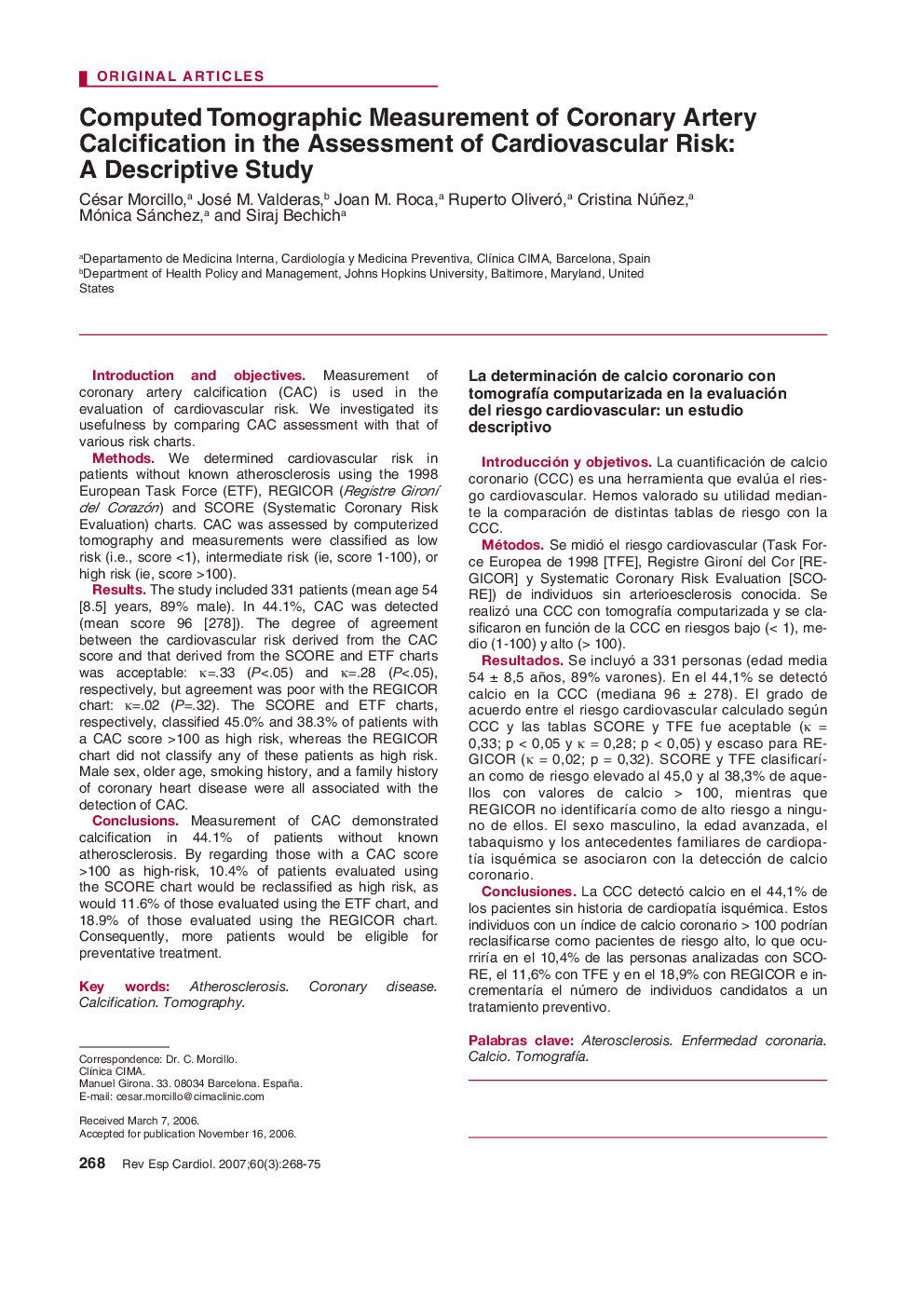| Article ID | Journal | Published Year | Pages | File Type |
|---|---|---|---|---|
| 3017543 | Revista Española de Cardiología (English Edition) | 2007 | 8 Pages |
Introduction and objectivesMeasurement of coronary artery calcification (CAC) is used in the evaluation of cardiovascular risk. We investigated its usefulness by comparing CAC assessment with that of various risk charts.MethodsWe determined cardiovascular risk in patients without known atherosclerosis using the 1998 European Task Force (ETF), REGICOR (Registre Gironí del Corazón) and SCORE (Systematic Coronary Risk Evaluation) charts. CAC was assessed by computerized tomography and measurements were classified as low risk (i.e., score <1), intermediate risk (ie, score 1-100), or high risk (ie, score >100).ResultsThe study included 331 patients (mean age 54 [8.5] years, 89% male). In 44.1%, CAC was detected (mean score 96 [278]). The degree of agreement between the cardiovascular risk derived from the CAC score and that derived from the SCORE and ETF charts was acceptable: κ=.33 (P<.05) and κ=.28 (P<.05), respectively, but agreement was poor with the REGICOR chart: κ=.02 (P=.32). The SCORE and ETF charts, respectively, classified 45.0% and 38.3% of patients with a CAC score >100 as high risk, whereas the REGICOR chart did not classify any of these patients as high risk. Male sex, older age, smoking history, and a family history of coronary heart disease were all associated with the detection of CAC.ConclusionsMeasurement of CAC demonstrated calcification in 44.1% of patients without known atherosclerosis. By regarding those with a CAC score >100 as high-risk, 10.4% of patients evaluated using the SCORE chart would be reclassified as high risk, as would 11.6% of those evaluated using the ETF chart, and 18.9% of those evaluated using the REGICOR chart. Consequently, more patients would be eligible for preventative treatment.
Introducción y objetivosLa cuantificación de calcio coronario (CCC) es una herramienta que evalúa el riesgo cardiovascular. Hemos valorado su utilidad median-te la comparación de distintas tablas de riesgo con la CCC.MétodosSe midió el riesgo cardiovascular (Task Force Europea de 1998 [TFE], Registre Gironí del Cor [REGICOR] y Systematic Coronary Risk Evaluation [SCORE]) de individuos sin arterioesclerosis conocida. Se realizó una CCC con tomografía computarizada y se clasificaron en función de la CCC en riesgos bajo (< 1), medio (1–100) y alto (> 100).ResultadosSe incluyó a 331 personas (edad media 54 ± 8,5 años, 89% varones). En el 44,1% se detectó calcio en la CCC (mediana 96 ± 278). El grado de acuerdo entre el riesgo cardiovascular calculado según CCC y las tablas SCORE y TFE fue aceptable ([.kappa] = 0,33; p < 0,05 y [.kappa] = 0,28; p < 0,05) y escaso para REGICOR ([.kappa] = 0,02; p = 0,32). SCORE y TFE clasificarían como de riesgo elevado al 45,0 y al 38,3% de aquellos con valores de calcio > 100, mientras que REGICOR no identificaría como de alto riesgo a ninguno de ellos. El sexo masculino, la edad avanzada, el tabaquismo y los antecedentes familiares de cardiopatía isquémica se asociaron con la detección de calcio coronario.ConclusionesLa CCC detectó calcio en el 44,1% de los pacientes sin historia de cardiopatía isquémica. Estos individuos con un índice de calcio coronario > 100 podrían reclasificarse como pacientes de riesgo alto, lo que ocurriría en el 10,4% de las personas analizadas con SCORE, el 11,6% con TFE y en el 18,9% con REGICOR e incrementaría el número de individuos candidatos a un tratamiento preventivo.
